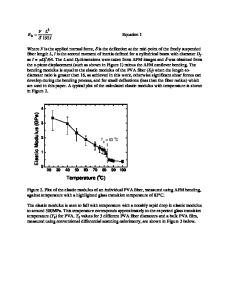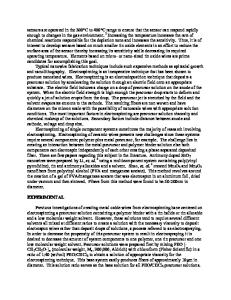Stress-strain behavior of individual electrospun polymer fibers using combination AFM and SEM
- PDF / 696,710 Bytes
- 5 Pages / 612 x 792 pts (letter) Page_size
- 95 Downloads / 309 Views
1185-II07-10
Stress-strain behavior of individual electrospun polymer fibers using combination AFM and SEM Fei Hang1, Dun Lu1, Shuang Wu Li1 and Asa H. Barber1 1 Centre for Materials Research & School of Engineering and Materials Science, Queen Mary University of London, Mile End Road, London E1 4NS, UK ABSTRACT Tensile deformation of individual electrospun polyvinyl alcohol (PVA) nanofibres was performed using a novel combination atomic force microscope (AFM)- scanning electron microscope (SEM) technique. The AFM was used to provide manipulation and mechanical testing of individual PVA nanofibers while the SEM was used to observe the deformation process. Resultant stress-strain curves show how the elastic modulus shows comparable, or even slightly increased, values to isotropic films. In addition, the electrospun fibers were tested to failure to measure their tensile strength. INTRODUCTION Polymers are typically processed into fibers especially when improvements in mechanical properties are required. Manufacturing methods such as melt spinning [1] and gel spinning [2] induce significant structural anisotropy with alignment of the polymer chains along the principle fiber axis. In some cases, the mechanical properties are considerable such as an elastic modulus of the order of many tens of GPa. Electrospinning is a historical process which has been recently revived for the production of polymer fibers [3] with diameters extending to the nanometer range [4]. The electrospinning process is potentially interesting as fibers are drawn from a polymer solution through an electric field to form solid fibers. The action of the electric field and the drawing process may induce structural anisotropy, thus improving the mechanical properties of the polymer. Mechanical testing of electrospun polymer fibers can be achieved through conventional techniques or the application of novel techniques to probe individual fiber mechanical performance. Conventional larger scale testing methods are expected to be inferior to mechanical testing of individual fibers due to the agglomeration of fibers which need to be tested together, resulting in external loading causing potential interfiber sliding as well as mechanical performance being averaged over the total number of fibers within the test. Tensile testing of individual electrospun polyethylene oxide fibers has been achieved using optical microscopy to observe the mechanical testing of a fiber of relatively large diameter [5]. One end of the fiber ends was attached to a micromanipulator whereas the other free end was glued to a small beam. Translation of the micromanipulator caused deformation of the fiber, with the beam bending used to quantify the force applied to the fiber. The technique was somewhat limited by manipulation of the fiber being observed by an optical method, indicating that electrospun fibers with diameters of a few hundred nanometers of less could not be resolved optically. Improvements in mechanical testing were achieved using a microelectromechanical device to apply
Data Loading...











